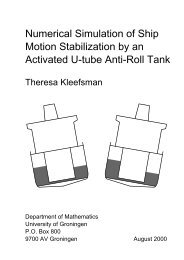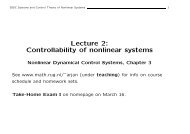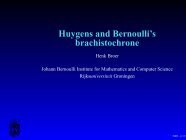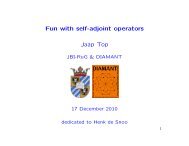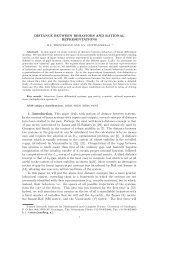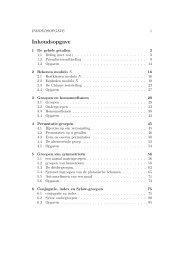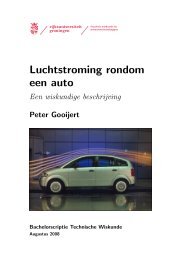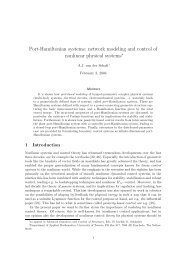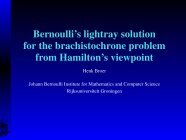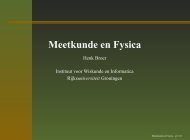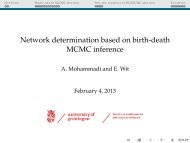Chaos and quasi-periodicity in diffeomorphisms of the solid torus
Chaos and quasi-periodicity in diffeomorphisms of the solid torus
Chaos and quasi-periodicity in diffeomorphisms of the solid torus
Create successful ePaper yourself
Turn your PDF publications into a flip-book with our unique Google optimized e-Paper software.
1.3 Summary <strong>and</strong> outl<strong>in</strong>e<br />
We summarise <strong>the</strong> rema<strong>in</strong>der <strong>of</strong> this paper, also expla<strong>in</strong><strong>in</strong>g its organisation. First <strong>in</strong> Section 2<br />
<strong>the</strong> results are presented, where all longer pro<strong>of</strong>s are postponed to Section 3. The contents <strong>of</strong><br />
Section 2 are related as follows to <strong>the</strong> subdivision regard<strong>in</strong>g model (2) as given <strong>in</strong> Section 1.1.<br />
Numerical examples beyond <strong>the</strong> skew product model (2), as well as details on methods <strong>and</strong><br />
on <strong>the</strong> <strong>in</strong>terpretation <strong>of</strong> <strong>the</strong> results, are given <strong>in</strong> Section 4.<br />
Normally hyperbolic <strong>in</strong>variant circles<br />
In Section 2.1 we start consider<strong>in</strong>g <strong>the</strong> more general context <strong>of</strong> <strong>the</strong> fully coupled family (6).<br />
A hyperbolic periodic po<strong>in</strong>t p, for ε = 0 corresponds to a normally hyperbolic <strong>in</strong>variant circle<br />
C .<br />
We start with <strong>the</strong> case where p is a saddle-po<strong>in</strong>t, so where C normally is <strong>of</strong> saddle type as<br />
well. Theorem 2 asserts that now, under quite general conditions, <strong>the</strong> closure Cl (W u (C )) <strong>of</strong><br />
<strong>the</strong> unstable manifold <strong>of</strong> C attracts an open set. In <strong>the</strong> families (6) <strong>and</strong> (2) this corresponds<br />
to an open set <strong>of</strong> parameter values. Note that <strong>the</strong> attract<strong>in</strong>g set Cl (W u (C )) is not m<strong>in</strong>imal<br />
if C carries Morse-Smale dynamics. In this situation, <strong>the</strong> case 2(a) <strong>of</strong> Section 2 is partially<br />
covered.<br />
Next, if p is a hyperbolic periodic po<strong>in</strong>t <strong>of</strong> <strong>the</strong> family (6), Theorem 3 guarantees that C<br />
is <strong>quasi</strong>-periodic for a parameter set <strong>of</strong> positive measure. If p is a saddle-po<strong>in</strong>t, <strong>in</strong> comb<strong>in</strong>ation<br />
with <strong>the</strong> previous paragraph, we partially cover case 2(b) <strong>of</strong> Section 1.1 for <strong>the</strong> family<br />
(2). However, if p is a periodic s<strong>in</strong>k, it follows that C is a <strong>quasi</strong>-periodic attractor, which<br />
completely covers case 1(b) <strong>of</strong> Section 1.1.<br />
In <strong>the</strong> case where p is a s<strong>in</strong>k <strong>and</strong> C carries Morse-Smale dynamics, for <strong>the</strong> general sett<strong>in</strong>g<br />
<strong>of</strong> (6), <strong>the</strong> m<strong>in</strong>imal attractors are periodic. For <strong>the</strong> family (2) this completely covers case<br />
1(a) <strong>of</strong> Section 1.1.<br />
Persistence <strong>of</strong> normally hyperbolic <strong>in</strong>variant circles generally follows by [20, Theorem 1.1].<br />
Theorem 2 is based on a result by Tangerman <strong>and</strong> Szewc, see [31, Appendix 3]. Our pro<strong>of</strong><br />
<strong>of</strong> Theorem 3 applies st<strong>and</strong>ard kam Theory, see [6, 5].<br />
The cases where Λ H > 0<br />
We now deal with <strong>the</strong> cases where <strong>the</strong> Hénon family is <strong>in</strong> a strange attractor. The ma<strong>in</strong><br />
ma<strong>the</strong>matical contents <strong>of</strong> this paper are formulated <strong>in</strong> Theorem 4 (<strong>in</strong> Section 2.2), which<br />
deals with <strong>the</strong> scaled skew product model (4). Here we establish <strong>the</strong> existence <strong>of</strong> Hénon-like<br />
strange attractors, which completely covers case 2(a) <strong>of</strong> Section 1.1 <strong>in</strong> suitable parameter<br />
ranges. For completeness, <strong>in</strong> Section 2.2 technical def<strong>in</strong>itions <strong>of</strong> ‘strange’, ‘Hénon-like’, etc.,<br />
are <strong>in</strong>cluded; compare with [14, 26, 39]. The pro<strong>of</strong> <strong>of</strong> Theorem 4 is based on [14, Theorem<br />
5.2].<br />
F<strong>in</strong>ally, <strong>in</strong> Section 2.3 we deal with <strong>the</strong> rema<strong>in</strong><strong>in</strong>g case, both for <strong>the</strong> skew product system<br />
(4) <strong>and</strong> for <strong>the</strong> more general system (6). Here we touch upon <strong>the</strong> existence <strong>of</strong> <strong>quasi</strong>-periodic<br />
Hénon-like attractors. Lemma 7 implies that <strong>in</strong> <strong>the</strong> product case ε = 0 a topologically<br />
transitive attractor occurs, hav<strong>in</strong>g a dense set <strong>of</strong> orbits with a positive Lyapunov exponent.<br />
Regard<strong>in</strong>g its persistence for |ε| ≪ 1, our conjectures <strong>and</strong> mostly computer suggested.<br />
Acknowledgements<br />
The authors are <strong>in</strong>debted to Henk Bru<strong>in</strong>, Àngel Jorba, Marco Martens, V<strong>in</strong>cent Naudot,<br />
Floris Takens, Joan Carles Tatjer <strong>and</strong> Marcelo Viana for valuable discussion. The first author<br />
8




